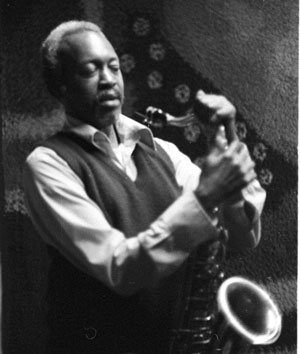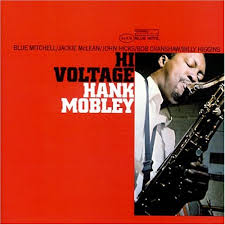Advance Notice – Hank Mobley
This 16-measure blues head is all about the rhythm. The first phrase of the melody is extended into a dotted quarter note pattern in the piano that really grooves. A full score and parts are available for the sextet arrangement.
- Recording: Hank Mobley - Hi Voltage
- Recorded on: October 9, 1967
- Label: Blue Note (BLP 4273)
- Concert Key: F
- Vocal Range: , to
- Style: Swing (medium up)
- Trumpet - Blue Mitchell
- Alto Sax - Jackie McLean
- Tenor Sax - Hank Mobley
- Piano - John Hicks
- Bass - Bob Cranshaw
- Drums - Billy Higgins
Purchase Advance Notice - Hank Mobley
Purchasing this song through our affiliate links with certain retailers provides jazzleadsheets.com with additional support to help keep us bringing you the best lead sheets available. Thank you!
Video
- Description
- Historical Notes
- Solos
- Piano Corner
- Bass Corner
- Drum Corner
- Guitar Corner
- Inside & Beyond
- Minus You
The melody has an unusual relationship to the changes: in the first 12 measures each melody phrase begins on the fourth of the chord (B♭ on F7, E♭ on B♭7). In context this highlights two different roles of the fourth—as a suspension going to the third, and as part of the blues scale, which is used in most of the melody. Despite the use of the fourth, the chord remains F7 and not F7sus; B♭ and A are played together in the piano voicing.
About the arrangement: A full score and parts are available for the sextet arrangement. For most of the melody, the alto and tenor sax play a countermelody (harmonized) below the trumpet, a descending line that fills in the dotted quarter notes of the melody with eighth notes. The rhythm of this line begins rather similarly to another song from the same Hank Mobley album, Two And One. The horns continue in harmony in the last four measures.
The lead sheet is the 1st part; for Guitar 1st part, play the C treble clef lead sheet up an octave.
For details on the rhythm section parts, click the Inside & Beyond tab.
Advance Notice is related, both melodically and harmonically, to Fletcher Henderson's Soft Winds, which Hank Mobley had played with the Jazz Messengers 12 years earlier, live at the Cafe Bohemia.
The rhythm section on this album does not appear on any other recordings. However, John Hicks and Billy Higgins played together on one other Blue Note session: Lee Morgan's "Taru," from February 1968. Hicks recorded a few times with Bob Cranshaw in the '70s, and with Higgins in the '80s and '90s.
Bass: The bassist's role is to create and maintain the 2-feel foundation for the first 12 measures of the 16-bar blues form, then switch to 4-feel for the last four measures of the form. The melody repeats before the solos. The solo section is 4-feel throughout.
Piano: Full piano voicings are shown condensed onto one staff. For the intro, the piano adds a four-measure dotted quarter note pulse, starting on the downbeat. This four-measure rhythmic pattern then continues for the next eight measures of this 16-bar blues before switching to a 4-feel melody to set up the head. The horn melody starts on the second beat, so the piano then switches its dotted quarter note pulse to start on the second beat instead of the downbeat. The piano keeps its newly-established four measure pattern for the next eight measures of the form before switching to more conventional comping for the last four-measure 4-feel section of the melody. The melody then repeats before solos. Solos are the 16-bar blues form of the melody, but it's 4-feel comping throughout.
Drums: Like the bass, the drummer's role is to cement the foundation. For the intro, we've elected to cue the piano rhythms in as a snare drum part, basically so you have a reference as to what the piano is playing against the 2-feel of the bass.
For the melody, where the piano switches its role to playing dotted quarter pulses starting on the second beat, we elected to indicate Billy Higgins' snare drum pattern, and showing you where the bass changes from 2-feel to 4-feel. We also couldn't resist notating Billy's classic one-measure set up into the 4-feel that he plays the second time through the melody on the original recording. Of course, on the repeating out melody, Billy plays some other incredible variations that drummers should check out. After the repeating melody, solos are 4-feel throughout. After the last soloist, D.S. for the melody as indicated on our Drum part.
Listen to the recording and check out the interesting way the rhythm section elongates the ending while the horns hold the last note. This is not shown in the parts. Both the bass and the drums go to a dotted quarter note pulse in the last two measures of the last chorus and continue for three more measures into a final hold.
Related Songs
Email Send Advance Notice to a friend

Hank Mobley
July 7, 1930 – May 30, 1986
Hank Mobley is one of the most acclaimed tenor saxophonists in modern jazz history. He is recognized by musicians and critics alike as one of the most important and eloquent jazz instrumentalists of all time. He recorded well over 100 of his own original compositions and left an indelible mark on the post-bop jazz scene. Read more...

